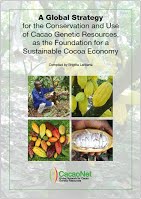Abstract
Global Strategy

CacaoNet coordinated the development of the Global Strategy for the Conservation and Use of Cacao Genetic Resources that was finalised in October 2012.
Below is the abstract and access to each section.
- You can download the full detailed version (186 pages and PDF 2.4Mb) here
- A summary booklet is also available (25 pages and PDF 2.5Mb) here
A Global Strategy for the Conservation and Use of Cacao Genetic Resources, as the Foundation for a Sustainable Cocoa Economy
Abstract
The future of the world cocoa economy depends on the availability of genetic diversity and the sustainable use of this broad genetic base to breed improved varieties. Decreasing cacao genetic diversity (in situ, on-farm and conserved in collections) is a serious problem and all its many causes need to be urgently addressed: the destruction of the Amazonian rainforests, changing patterns of land use, the spread of pests and diseases, sudden changes in climate, and threats from natural disasters and extreme weather. These factors are resulting in an irreversible loss of the cacao genetic diversity so essential for farmers, breeders, and consumers. Most of the countries involved in the improvement and production of cacao are highly dependent on genes and varieties characterized and conserved in other countries and regions. Effective management of cacao genetic resources can therefore only be carried out through international collaboration.
A considerable portion of the global cacao diversity is in situ, in farmers’ fields and held in genebanks around the world, including two international collections maintained at the Cocoa Research Unit of the University of the West Indies (CRU/UWI), Trinidad and Tobago, and at the Centro Agronómico Tropical de Investigación y Enseñanza (CATIE), Costa Rica. Unfortunately, much of the genetic resources maintained in national collections is under-used or at risk, and funding remains insufficient and unstable.
The vision of the Global Strategy for the Conservation and Use of Cacao Genetic Resources is to improve the livelihoods of the 5-6 million farmers in developing countries across tropical Africa, Asia and Latin America and the 40-50 million people who depend upon cocoa for their livelihoods. The specific goal is to optimize the conservation and maximize the use of cacao genetic resources as the foundation of a sustainable cocoa economy. This it does by bringing together national and international players in public and private sectors. The expected outputs are: (1) the cacao genepool is conserved in situ and ex situ for the long term by a global network of partners, (2) the global system for the safe exchange of cacao germplasm is strengthened, (3) the use of cacao genetic diversity is optimized and (4) the effectiveness of global efforts to conserve and use cacao genetic resources is assured. To ensure these outputs are implemented, the first and urgent task will be to secure funding for the existing cacao genetic diversity currently maintained in ex situ collections and accessible in the public domain. CacaoNet will work towards the establishment of an endowment fund for the conservation and use of the most valuable resources in perpetuity.
At the centre of the Global Strategy is the Global Strategic Cacao Collection (GSCC): a “virtual genebank” of accessions of highest priority for conservation, wherever they are physically located. The accessions will be selected to capture the greatest range of genetic (allelic) richness and key traits of interest to users. The inclusion of materials in the GSCC will be on the basis that governments concerned will be willing to place them in the public domain, and will take the necessary political and legal steps to do so.
The Global Strategy, developed by the Global Network for Cacao Genetic Resources (CacaoNet), is the result of a consultation process that drew upon the global cocoa community’s expertise in all aspects of cacao genetic resources. It provides a clear framework to secure funding for the most urgent needs to ensure that cacao diversity is conserved, used and provides direct benefits to the millions of small-scale cacao farmers around the world.